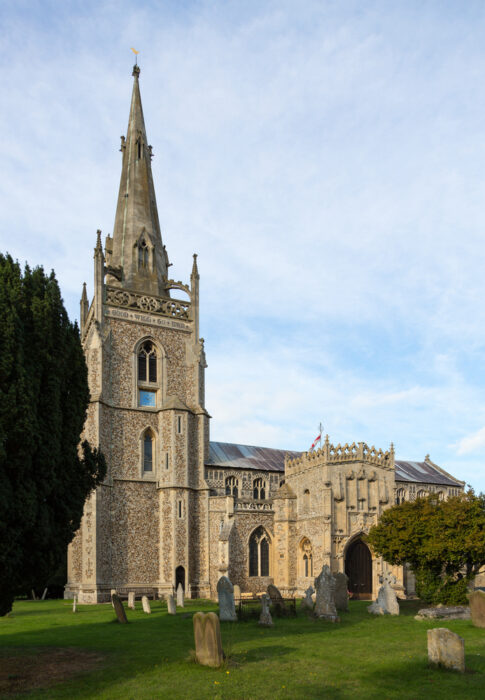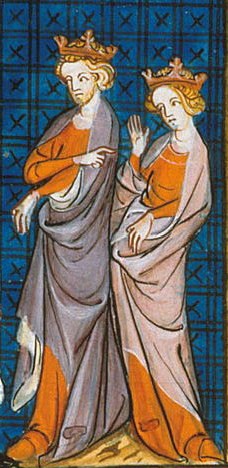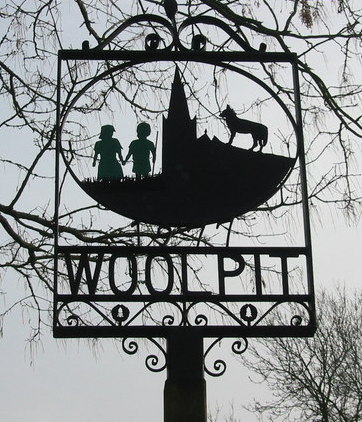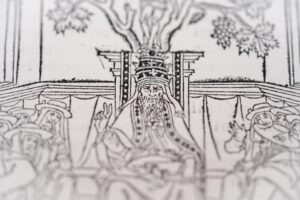Once upon a time in the 12th century, two odd children arrived in a little English village. The boy and girl spoke an unknown language, wore strange clothes, and, most peculiarly, had green skin. The tale of the Children of Woolpit is a pesky medieval mystery that has not been solved.
The strangers arrive
In the 12th century, England was unstable, and life was messy. A century before, in 1066, William the Conqueror took over a volatile kingdom already suffering from a succession crisis. He suppressed Anglo-Saxon revolts, and no peace lasted long. In the years that followed, strife and violence continued.

Bury Saint Edmunds in Suffolk. Photo: Steve Heap/Shutterstock
In this time of upheaval, a young boy and an older girl wandered into the village of Woolpit. Woolpit, nestled in Suffolk’s rolling hills, is a play on “wolf pit.” Villagers used wolf pits to capture the region’s wolves.
The children’s appearance startled the locals. With green skin and unusual clothing, they didn’t speak English, French, or Latin. The villagers tried to feed them, but the pair refused the food. Strangely, they ate only raw broad beans.
Landing in the care of Sir Richard de Calne, a local knight, the children were gradually weaned off their bean-only diet. As their diet changed, their skin color returned to a normal pink/white. But soon after, the boy fell ill and died. The girl survived and worked in the knight’s household. She was baptized and given the name Agnes.
A tall tale
Eventually, Agnes learned English and revealed the mystery of her identity. She claimed they came from St. Martin’s Land, a land of perpetual twilight deep underground. The sun never shone in St. Martin’s Land, but a river ran through their subterranean home. The children arrived in Woolpit after following cattle and a series of bells.
Agnes married a nobleman, Richard Barre, the archdeacon of Ely in Cambridgeshire. Barre was a real figure who served Henry II as a judge and ambassador.
Several sources cite the story of the green children: Ralph of Coggeshall (an abbot), William of Newburgh (a member of the Augustinian religious order), William Camden (an English antiquarian), and Bishop Francis Godwin (a historian and fiction writer).
Wrote Camden: “Wulpet is a mercat towne, how two little boies of a green color, and of satyrs kinde, after they had made a long journey by passages under the ground, from out of another world, from the Antipodes and Saint Martin’s Land, came up here.”

Henry II and Eleanor of Aquitaine. Photo: Unknown
Flemish migrants or fairies?
The green children became a common folktale, with the children typically described as fairies visiting the human world. Historian Jeffrey Jerome Cohen believes the story symbolizes the struggle between different ethnic groups in England during the Middle Ages. However, there might be some truth to the tale. Agnes does show up in historical records, listed as the wife of Richard Barre.
Historians suggest that the children were Flemish. There were several waves of Flemish immigration to England. The first came in 1066 with William the Conqueror’s invasion. William’s queen was Matilda of Flanders.
In the 12th century, more Flemish migrants arrived, fleeing environmental disasters and overpopulation. Henry I welcomed them into England, gifting them land in Pembrokeshire. From there, they spread out through England. However, their good fortune did not last. Henry II started persecuting the Flemish in 1154, believing they impeded English trade.
The town of Fornham St Martin is not far from Woolpit. It is the site of the 1173-1174 revolt against Henry II. The battle included thousands of Flemish mercenaries, and many ordinary Flemish villagers were caught up in the conflict. Some historians believe that the children of Woolpit might have been Flemish immigrants who escaped into the forest or local caves.
What caused the green skin?
As for the children’s green skin, certain conditions can alter human skin color. In the 1820s, the Fugates family in the U.S. made the news because they had blue skin. They carried a rare blood disorder. A more recent example is Paul Karason, a man from Washington whose skin turned blue because of long-term exposure to silver chloride.
Perhaps the children suffered from a genetic mutation or were exposed to copper. If the children only ate beans, they may have suffered from a vitamin and mineral deficiency that could have turned their skin green. Researchers suggest they had hypochromic anemia, also known as chlorosis, a vitamin B6 deficiency that can create a greenish tint in the skin.

Woolpit sign depicting the children. Photo: Rod Bacon/Wikipedia Commons
Is it possible that an underground community existed? If a Flemish community sheltered underground from Henry II’s forces, they may have lacked access to sunlight and nutritious food. The children’s descriptions of a river and perpetual twilight could be a cave system used by refugees.
Folklorists believe the story has something to do with St. Martin of Tours (a former Roman soldier who converted to Christianity) and the Celtic underworld. St. Martin of Tours supposedly had a dream where he divided his robe and gave one of the pieces to Christ.
He is the patron saint of weavers and tailors. St. Martin’s Day is his feast day, also called Old Halloween in the Middle Ages. The day celebrated the transition from autumn to winter. Some cultures, including the Celts, associated broad beans with death and the underworld. While intriguing, these two elements do not work well enough within the narrative to form a solid link.
Conclusion
It seems plausible that the tale of the green children of Woolpit is based on real stories of sickly Flemish refugees. St. Martin’s Land could be a play on the nearby town of Fornham St Martin. The area also features chalk caves and tin mines.
Religion, mythology, and truth seem to have all meshed into a wondrous fairytale.






